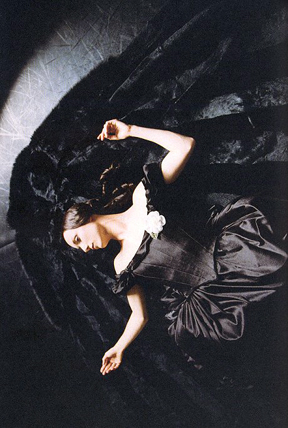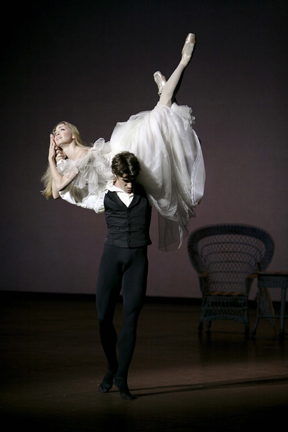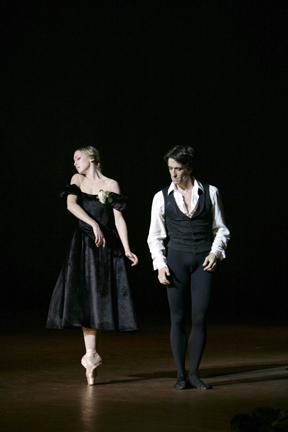Marguerite in Paris
"Lady of the Camellias"
Chor. John Neumeier, music by Frederic Chopin
Paris Opera Ballet,
Palais Garnier,
Paris
July and September 2006
By Marc Haegeman
Copyright 2006 by Marc Haegeman
 “Lady of the Camellias”, John Neumeier’s adaptation of the famous novel by Alexandre Dumas fils, always appeared like a rather heavy meal to me and seeing it now performed by the Paris Opera, which added the ballet to its repertory at the end of last season and opened the current one with it, hasn’t really changed my feelings. On the contrary, the ballet seems to have aged rather badly and after two performances at the Palais Garnier I still need to be convinced that Neumeier’s slap-in-your-face approach — which some insist to be poetic — to the Marguerite and Armand story suits the French sophistication and cool that well.
“Lady of the Camellias”, John Neumeier’s adaptation of the famous novel by Alexandre Dumas fils, always appeared like a rather heavy meal to me and seeing it now performed by the Paris Opera, which added the ballet to its repertory at the end of last season and opened the current one with it, hasn’t really changed my feelings. On the contrary, the ballet seems to have aged rather badly and after two performances at the Palais Garnier I still need to be convinced that Neumeier’s slap-in-your-face approach — which some insist to be poetic — to the Marguerite and Armand story suits the French sophistication and cool that well.
Of course, Neumeier enjoys a spotless reputation at the Paris Opera. Several leading dancers singled him out as the favourite choreographer they worked with, while his version of Léo Delibes’ “Sylvia” created for Paris is considered one of the glories of the last decade there. But in the case of “Lady of the Camellias”, which was created in 1978 for Stuttgart Ballet, I wonder if Neumeier’s personal take on this quintessentially Parisian story is such a great asset for the Opera.
With the passing of time, it’s easy to point out the novelties of the day when the work was created — such as beginning the ballet with the house lights still up, to complete silence, or the concept of a multilayered narrative — however I doubt if Neumeier’s choreography has ever been innovative or original — it surely isn’t now. And a company like the Paris Opera only exposes its flaws even more. The small-scaled and basically constricted way of moving (as if the choreographer doesn’t trust the technical possibilities of his dancers), some of the most uncomfortable duets and trios ever, spiced with those fearful Cranko-like laments which stubbornly fail to turn music into emotion, became all too obvious. Just as in Kenneth MacMillan’s full-evening ballets each act has its big duet between the leading characters. Yet unlike with MacMillan their choreographic inventiveness and musicality is far too meagre to justify their interminable length.
 Neumeier used a selection of beautiful if unrelated Chopin pieces for piano solo or piano and orchestra, although his theatricality hardly ever matches their poetry and delicacy. Armed with his literary references, the structure of the narrative is handled quite adroitly, with flashbacks, story within story and so on, yet individual scenes and situations are painted with such broad and flashy strokes that at times it’s almost “La Traviata” in graffiti. The characters are saddled with gestures that would even register as far as the banlieus of Paris, be it the overly ostentatious fits of coughing of Marguerite, which had members of the audience in giggles, to the frolicking of Armand and his new flirt, set upfront, at the side of the orchestra pit as close as possible to the audience, in order to make sure that nobody misses its meaning, and to the naked guy who has to lie down on top of our heroine behind a transparent screen at the end of the 2nd Act, so that we would all understand she returned to her old habits. Neumeier may have had his doubts about the imagination of his audiences back in the late seventies, but nearly thirty years on this paternalistic approach to theatre is at best a charming relic.
Neumeier used a selection of beautiful if unrelated Chopin pieces for piano solo or piano and orchestra, although his theatricality hardly ever matches their poetry and delicacy. Armed with his literary references, the structure of the narrative is handled quite adroitly, with flashbacks, story within story and so on, yet individual scenes and situations are painted with such broad and flashy strokes that at times it’s almost “La Traviata” in graffiti. The characters are saddled with gestures that would even register as far as the banlieus of Paris, be it the overly ostentatious fits of coughing of Marguerite, which had members of the audience in giggles, to the frolicking of Armand and his new flirt, set upfront, at the side of the orchestra pit as close as possible to the audience, in order to make sure that nobody misses its meaning, and to the naked guy who has to lie down on top of our heroine behind a transparent screen at the end of the 2nd Act, so that we would all understand she returned to her old habits. Neumeier may have had his doubts about the imagination of his audiences back in the late seventies, but nearly thirty years on this paternalistic approach to theatre is at best a charming relic.
The ballet runs for far too long with three acts of 40 minutes and is, except for some droll moments in the countryside act — which aren’t exactly of the most refined taste — devoid of humour, straining our well-known ‘arc of attention’ even more. Designer Jürgen Rose places the work in the appropriate 1840’s setting. His sets are minimal, but with his elaborate costumes he not only hinders much of the dancers’ movements, he also turns the scenes in the theatre and in the ballroom into flashy dress parades. I have lost count how many times Marguerite changes her dress in the course of the evening.
In spite of its ambitions “Lady of the Camellias” seems to have became more than anything a ballerina vehicle. The ensemble scenes which suffer from uninspired choreography for the corps, were also riddled with hollow characterisations and pointless character building — look, how busy everybody is — and some of the more theatrical moments which did work in previous performances, hardly registered here — such as the entrance of the servant at the very beginning, or the confrontation between Marguerite and Armand’s father.
The performances of the leading ladies nonetheless constituted for my money the main interest of these Parisian “Lady of the Camellias”. Both Eleonora Abbagnato — in her debut performance — and Clairemarie Osta in the second run last September, gave interesting portrayals of Marguerite Gautier, transcending the clichés with their personalities. Abbagnato seemed to grow into the role in the course of the evening and although the opening scenes were questionable by her much too healthy look and matter-of-fact appearance, by the final act her character had become beautifully moving. Clairemarie Osta clearly had thought a great deal about the role. More mature, she was also more expressive from the start, immediately drawing the audience into her well-handled shifts of mood and mannerisms. She didn’t take Armand Duval to be genuinely in love with her either, but was pleasantly confused when she finally found out he really was, even though he became aware of her mortal illness. Neither one, though, could do much with the endless and clumsy love duet in the 2nd Act, set in the countryside, which doesn’t lead to anything except some very awkward lifts (how many layers of dress can a dancer have in his face?) and obvious frantic grabbing and hugging. Yet, in the 3rd Act duet, embodying the dramatic development of Marguerite’s and Armand’s final impassionate meeting — both Abbagnato and Osta made the most of the opportunities given.
 On the other hand, neither Benjamin Pech (with Abbagnato) nor Mathieu Ganio could do much with the role of Armand Duval, which is so clichéd and over the top it’s almost painful to watch. The sobbing, the crawling, the fainting, the fits of anger are all staged in such overdramatic proportions by Neumeier they miss their point. When Ganio threw himself at the feet of Osta, members of the audience were chuckling again. Both Pech and Ganio were dependable partners, though, handling the break-back lifts rather well and making the best of that infirm solo at the end of the 2nd Act.
On the other hand, neither Benjamin Pech (with Abbagnato) nor Mathieu Ganio could do much with the role of Armand Duval, which is so clichéd and over the top it’s almost painful to watch. The sobbing, the crawling, the fainting, the fits of anger are all staged in such overdramatic proportions by Neumeier they miss their point. When Ganio threw himself at the feet of Osta, members of the audience were chuckling again. Both Pech and Ganio were dependable partners, though, handling the break-back lifts rather well and making the best of that infirm solo at the end of the 2nd Act.
The acclaimed étoile from the 1970-80’s Michaël Denard, appearing as a guest, seemed completely miscast as Armand’s father who thwarts the lovers’ happiness. His gestures and facial expressions verged on caricature. It was left to Kader Belarbi (in the cast with Osta and Ganio) to skip most of the mannerisms and retain dignity as well as authority.
By endlessly drawing out the parallel between the destinies of Marguerite and Manon which Neumeier found in Dumas’ novel, the concept of story within story is seriously weakened. Moreover, I didn’t feel that Laure Hecquet (in the cast with Abbagnato and Pech) nor Isabelle Ciaravola, both partnered by Christophe Duquenne as Des Grieux, were dramatically up to their task. Perhaps other casts (Delphine Moussin and Jean-Guillaume Bart were also cast) might have been more rewarding, but here the repeated appearances all the ballet long quickly became tedious and eventually obstructed the dramatic flow of the main story.
Photos (from top):
Clairemarie Osta as Marguerite Gautier, photo by Ann Ray.
Eléonora Abbagnato - Benjamin Pech
© Photo(s) Anne Deniau.
Volume 4, No. 36
October 9, 2006
copyright ©2006 Marc Haegeman
www.danceviewtimes.com